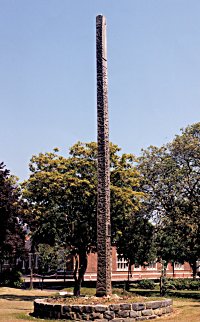Location
Formerly in the Rose Garden to the South West of the Museum Block at HMS Excellent, but now on permanent loan to the Cambridge University Museum of Archaeology and Anthropology.

1920 - 2007
(Prepared by Lieutenant Commander Brian Witts MBE, Curator, HMS Excellent Museum)
Background
In researching this artifact, which was presented to HMS Excellent in 1920, it was confirmed by the curator of the Maori Artifacts at the Auckland Museum that Pouhaki is the correct term as it is a symbol of Power - Mana - Authority and as such was the type of gift that the combined tribal chiefs would wish to present to a future King. We must not lose sight that the Pouhaki was initially carved by Tene Waitere as a flagpole.
The Carver
Tene Waitere was borne in 1854 at Mangamumu in Northland, his mother having been captured during a Ngapuhi attack on Rotorua in 1823 was forcibly married to a Ngapuhi named Waitere. When he was only a few years old, his uncle came from Rotorua and brought his mother and her two children back to Ruato on Lake Rotoiti. Tene was chosen to be trained as a carver by Wero the master of the Ngati Tarawhai carving school.
At the time of the Tarawera Eruption in 1886, Tere and his wife Ruihi Te Ngahue of the Tuhourangi Tribe along with their family were living in Te Wairoa and were among the survivors who sheltered in the famous carved house Hinemihi. After the disaster, along with other Tuhourangi survivors of the eruption, Tene's family was given land at Ngapuna and Whakarewarewa by Wahiao.
He lived first at Hgapuna, until 1892 when the Geyser Hotel was being built at Whakarewarewa. The first Manager of the hotel, C E Nelson, was very keen to preserve the art of carving and he employed Tene Waitere as a professional carver at the hotel, Tene therefore moved to Whakarewarewa. During these years Tene often had to struggle to provide for his family which included his wife, daughter and two grand-children, Ngatai and Rangitiaria (later Guide Rangi). According to his grand-daughter, Rangitiaria, Tene could not speak English and could neither read or write. He died in September 1931 at the age of 77.
Amongst his works, beside the flagpole presented to the Prince of Wales in 1920, include a presentation to the Duke of York (later King George V) of a model of the Te Arawa canoe. Later King George VI and Queen Elizabeth received a model Pataka (food house). One of his most famous carvings is in the gateway at the western entrance of Whakarewarewa, sometimes referred to as Lovers Gate.
The Visit of the Prince of Wales
After the Great War of 1914-18 King George V sent his son and heir on a tour of the Dominions that has assisted England during the war to thank them for their support.
The Prince of Wales arrived in New Zealand on 24 April 1920 onboard the battlecruiser HMS RENOWN, landing ashore in Auckland to a tumultuous welcome from the school children of the Dominion and a Parade of returned soldiers. In the Auckland Domain in the afternoon he spoke to the soldiers and issued some with their WWI medals. Visits were also made to hospitals throughout the tour to visit wounded soldiers who were still convalescing.
It is reported in the Auckland Weekly News of the time that the Prince travelled by the Royal Train to Rotorua, arriving on Wednesday 28 April, met with the local Arawa Tribe at Ohinemutu where he was presented with several fine mats and cases of pipes carved in Maori style and a Taiaha ( native spear). Due to the inclement weather of that day the rest of the official programme was curtailed.
On Thursday 29 April the Prince visited Arawa Park where the Auckland Weekly News of 6 May reports 5,000 to 6,000 Maoris had gathered from throughout the country to a meeting (Hui) to entertain the Prince with traditional dances and songs. It was at this Hui that the flagpole can be clearly seen in the background of the photograph taken to mark the event. It is bedecked with the tribal banners of the tribes present at the meeting. It is not clear who made the presentation nor at which stage the flagpole was presented to the Prince.
The wood from which the pole was carved is thought to be Padocarpur totara - a New Zealand hardwood long used as the preferred wood of Maori carvers (also used historically for railway sleepers and similar purposes). It took Tene Waitere one week to carve the pole.
It is regretted that no documentation or photographs exist in the archives of the Excellent Museum as to the presentation of the Pouhaki other than the following information written on a plaque displayed on the pole which reads: "On the return of HMS RENOWN on the 17 July 1920 the Pouhaki was presented to the Captain of HMS Excellent - Captain F H Mitchell DSO." The flagpole was placed in the 'Wallaby' garden part of the zoo complex situated in the centre of 'Whale Island' where it has remained for 87 years
After 87 years exposed to the elements the pole is showing signs of deterioration. Over the past three years it has become obvious that the wood is splitting and even more obvious a woodpecker is creating a large hole at the top of the pole.
